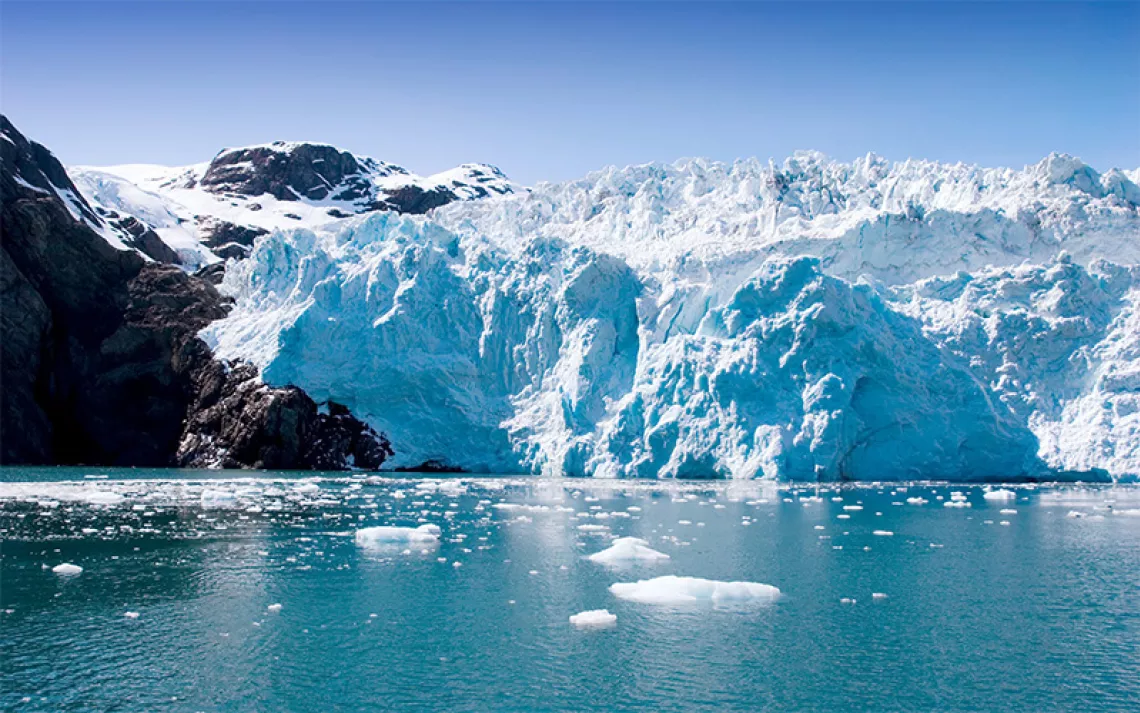Who Had Good Climate Data in the 70s? Exxon, That’s Who.
Exxon not only knew, Exxon knew a lot

An ice sculpture fashioned by protesters slowly melts outside an ExxonMobil shareholders meeting in Dallas. | Photo by LM Otero|AP
Exxon didn’t just know about climate change. Exxon knew so much about climate change that, in the 1970s and '80s, Exxon’s internal predictions of how climate change would play out were as good or better than projections made by climatologists like NASA’s James Hansen, the scientist who first warned Congress about the threat of global warming in 1988.
That’s the conclusion of research published this week in Science by science historians Naomi Oreskes and Geoffrey Supran, and physicist and climatologist Stefan Rahmstorf. The three searched Exxon’s public archives, Exxon-related documents collected by Climate Files, a public database of climate information, and Exxon records that Inside Climate News found in the archives of the University of Texas-Austin, MIT, and the American Association for the Advancement of Science.
Ultimately, the researchers collected 32 internal documents (produced by ExxonMobil scientists between 1977 and 2002) and 72 peer-reviewed scientific publications (authored or coauthored between 1982 and 2014 by scientists working for ExxonMobil). Within those documents were 16 distinct, Exxon-subsidized projections of how global mean surface temperatures would change if people continued digging up and burning oil and gas.
These projections had taken a tremendous amount of effort and research funding to produce, but until they caught the trio’s interest, no independent researchers had studied them in any depth—possibly because there was plenty of other, less mathematically complicated scandal in the Exxon documents. “Many of the uncovered fossil fuel industry documents include explicit projections of the amount of warming expected to occur over time in response to rising atmospheric greenhouse gas concentrations,” the authors wrote. “Indeed, no one has systematically reviewed climate modeling projections by any fossil fuel interest. What exactly did oil and gas companies know, and how accurate did their knowledge prove to be?”
To find out, Oreskes, Supran, and Rahmstorf compared the projections produced by the Exxon scientists with other climate models—and to what actually happened over the next few decades. Here are a few highlights of what they learned.
Exxon was extremely good at climate predictions
Ever since the Inside Climate News investigation in 2015, it’s been public knowledge that Exxon has known since at least the late 1970s that drilling for oil and gas could lead to global warming with “dramatic environmental effects before the year 2050.” The American Petroleum Institute had known this since at least the 1950s, and the coal industry and most utilities since the 1960s. Ford and General Motors were aware of the threat of global warming since the 1970s at least.
What makes Exxon’s climate awareness unusual is how detailed and accurate it was, both in its Exxon years and after it merged with Mobil in 1998 to become ExxonMobil. The trio of researchers concluded:
“Our results show that in private and academic circles since the late 1970s and early 1980s, ExxonMobil predicted global warming correctly and skillfully. Using established statistical techniques, we find that 63 to 83% of the climate projections reported by ExxonMobil scientists were accurate in predicting subsequent global warming. ExxonMobil’s average projected warming was 0.20° ± 0.04°C per decade, which is, within uncertainty, the same as that of independent academic and government projections published between 1970 and 2007. The average “skill score” and level of uncertainty of ExxonMobil’s climate models (67 to 75% and ±21%, respectively) were also similar to those of the independent models.”
By way of comparison, the global warming predictions that climatologist James Hansen presented to the US Congress in 1988 had skill scores ranging from 38 to 66 percent.
ExxonMobil scientists were aware that human-caused global warming would first be detectable in the year 2000
They also did a good job estimating how much CO2 would lead to dangerous warming.
Exxon was extremely dedicated to not sharing those climate predictions
An Exxon document that was discussed in an internal briefing in 1982 contained “an estimate of the average global temperature increase” under the “Exxon 21st Century Study–High Growth scenario” for CO2. That estimate was also used in a 1982 briefing on the “CO2 ‘Greenhouse’ Effect” that was circulated to company management. Meanwhile, the briefing itself was labeled as “proprietary information for authorized company use only.”
While scientists in both government and academic posts sounded the alarm about climate change and its risks, ExxonMobil flat-out lied
Exxon did this in a variety of ways—hyping the uncertainty of some data, making fun of other people’s climate models, pretending not to know anything about anything, and never mentioning the possibility that digging for more oil and gas ran an increased risk of leaving the company and its stakeholders with “stranded assets.” In 1999, ExxonMobil’s CEO Lee Raymond said future climate “projections are based on completely unproven climate models, or, more often, sheer speculation.” Over a decade later, then–ExxonMobil CEO Rex Tillerson called climate models “not competent” and added, “We do not really know what the climate effects of 600 ppm versus 450 ppm will be because the models simply are not that good.”
But the ExxonMobil climate models really were that good
ExxonMobil even calculated how much of a “carbon budget” the world would have to remain within in order to forestall the grim future of bad weather ahead. “Yet, to our knowledge,” wrote Oreskes, Supran, and Rahmstorf, “ExxonMobil did not alert investors, consumers, or the general public to this constraint.” Instead, the company continued on its 130-year journey toward its ultimate ranking in the top four of all villains responsible for climate change.
 The Magazine of The Sierra Club
The Magazine of The Sierra Club







